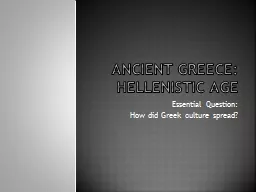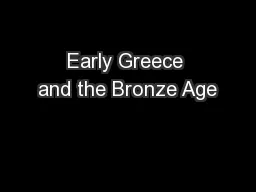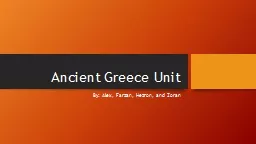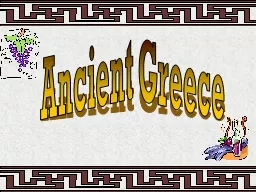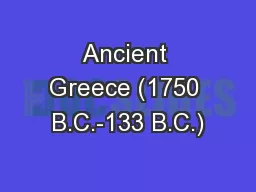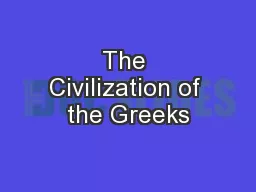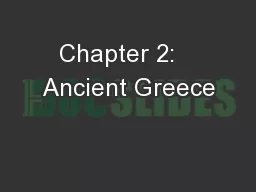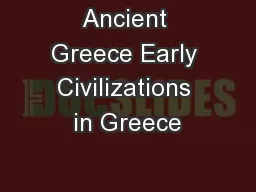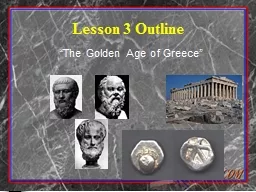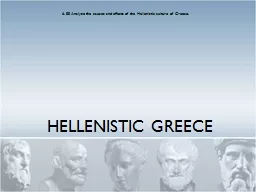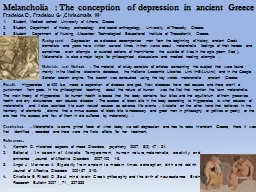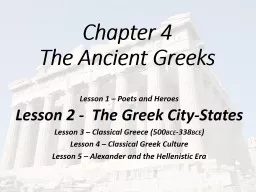PPT-Ancient Greece: Hellenistic age
Author : genesantander | Published Date : 2020-08-07
Essential Question How did Greek culture spread Alexander the great The Macedonians north of Greece emerged as a powerful kingdom King Philip II took control and
Presentation Embed Code
Download Presentation
Download Presentation The PPT/PDF document "Ancient Greece: Hellenistic age" is the property of its rightful owner. Permission is granted to download and print the materials on this website for personal, non-commercial use only, and to display it on your personal computer provided you do not modify the materials and that you retain all copyright notices contained in the materials. By downloading content from our website, you accept the terms of this agreement.
Ancient Greece: Hellenistic age: Transcript
Essential Question How did Greek culture spread Alexander the great The Macedonians north of Greece emerged as a powerful kingdom King Philip II took control and wanted to unite Greece under Macedonia and eventually conquer Persia. Alexander the Great was a young general who amassed the largest empire of the ancient world in just thirteen years. . His career was brief because he died a young man, . but Alexander’s . legacy was a . Free to share, print, make copies and changes. Get yours at . www.boundless.com. Available on the Boundless Teaching Platform. Using Boundless Presentations. The Appendix. The appendix is for you to use to add depth and breadth to your lectures. You can simply drag and drop slides from the appendix into the main presentation to make for a richer lecture experience.. Ancient Greece. Greece – Bronze age. Origins of civilization. Prehistory. History. Greece – Bronze age. Origins of civilization. Prehistory. Includes Paleolithic and other . prehistorical. categories. By: Alex, Farzan, Hezron, and Zoran. Introduction to Ancient Greece. Ancient Greece consisted of many civilizations inhabiting the surrounding islands of the Aegean sea. During the Bronze Age, the Minoans and Mycenaean both rose and declined heavily on the island of Crete. Ancient Greece contained civilizations rich in culture, philosophy, and mythology. During the Classical Greek Period (500 – 323 BCE), an intellectual revolution occurs in many areas surrounding Ancient Greece, including city-states (except for Sparta of course). isthmus. harbor. A small strip of land, with. water on both sides, that. connects two larger areas of. land.. A sheltered place with deep. water close to shore.. trireme. A large fighting ship used by. Lesson . 4 . Alexander the Great and the Legacy of Greece. . Learning Objectives. Explain how Alexander the Great built an extensive empire.. Describe the empire’s cultural impact.. Identify major Hellenic Greek scientists and their discoveries and innovations.. Cox Paisley IB. WHAP. Why Homer was used as the basis for Greek education. The . Polis,. or city-state, and how the city-states of Athens and Sparta differed. What the greeks meant by democracy, and in what way the Athenian political system was a democracy?. Aegean. Cultures. Geography. The Aegean Cultures are found in the area of the Aegean Sea.. The terrain is . rocky. with a huge dependency on the . water. .. Aegean Cultures. Cycladic. Culture. Existed around 2500-2000 B.C.E.. The Parthenon. I. Geography. Mountains. divided Greece and led to cultural and political divisions.. Greece is made up of two . peninsula. (southern most part of the Balkan Peninsula and the Peloponnese Peninsula) that is . 1) The Ancient Athenians are credited with: . Inventing and using the wheel . Eliminating slavery . Establishing a democratic government . Inventing the printing press . 2) The ancient Greek city-state of Sparta: . The Greeks Clash with the Persians. . a. At the time Athens was growing more powerful, Persia was the strongest military power in . . the world. . . b.. Persians. invaded Greece at a plain northeast of Athens called . Introduction. In 336 B.C., Alexander the Great became the leader of the Greek kingdom of Macedonia. By the time he died 13 years later, Alexander had built an empire that stretched from Greece all the way to India. . Fradelos. E. 1. , . Fradelou. G. 2. ,. Chrisomalis. . M. 3. Student. , Medical school ,University of Athens, . Greece. Student. , Department of history ,archaeology and social anthropology, University of . Lesson 1 – Poets and Heroes. Lesson 2 - The Greek City-States. Lesson 3 – Classical Greece (500BCE-338BCE). Lesson 4 – Classical Greek Culture. Lesson 5 – Alexander and the Hellenistic Era. Macedonians Invade Greece .
Download Document
Here is the link to download the presentation.
"Ancient Greece: Hellenistic age"The content belongs to its owner. You may download and print it for personal use, without modification, and keep all copyright notices. By downloading, you agree to these terms.
Related Documents

